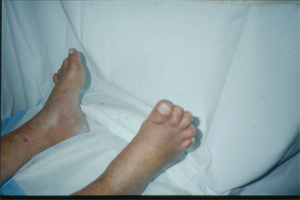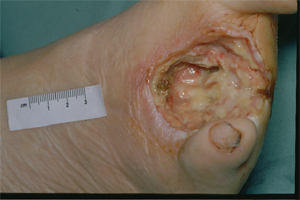Diabetic Vignettes
‘I marvel that society will pay a surgeon a great deal of money to amputate a limb but nothing to save it’
George Bernard Shaw
I have seen many patients with diabetes mellitus (DM) who have foot ulcers. Some have been so bad as to require amputation of one or both lower limbs. Yet our focus really should be on preservation of the lower limbs, rather than trying to treat the ulcers. Everyone with diabetes should receive basic foot-care education, and regular foot examinations. Foot examinations can be done very simply. Check out this fabulous informative site from an Australian podiatrist :www.2foot.com.au
I want to share a few interesting pieces from papers found on Medline. I urge you all to read the full texts because the information is not only fascinating but scary. Could the increase in the number of patients with DM mean that there will be an increase in the numbers with foot ulcers leading to amputation?!
|
| Amputation of one limb increases the risk of loss of the second limb and is associated with a 50% five-year mortality.
Ref: Apelqvist J, Larsson J, Agardh C-D. Long term prognosis for diabetic patients with foot ulcers. J Intern Med 1993; 233: 485-491. |
| 30% of diabetic patients have contralateral limb amputation within 3 years of the first amputation.
Ref: Most RS, Sinnock KP. The epidemiology of lower extremity amputations in diabetic individuals. Diabetes Care 1983; 6:87–91 |
Peripheral neuropathy, peripheral vascular disease deformities of the feet and infection can lead to ulceration and / or amputation.

Note the ‘clawed toe deformity’ of this diabetic patient.

This patient with peripheral neuropathy presented with a large foreign body in the plantar aspect of the foot and life-threatening infection. The three middle toes required amputation together with deep debridement. The wound healed remarkably!
(Photographs from personal collection)
The risk for the development of ulceration can be assessed by basic clinical examination of the foot. Anyone can learn to do it! Family members, nursing and medical staff, podiatrists, personal care assistants and assistants in nursing in aged care facilities can learn how to do it!! Just use the teaching tools and assessment tools on this excellent website. www.2foot.com.au



Finally! This is just what I was looking for.